
Private J. Arthur Maguire of the 2nd Battalion enlisted at age 21 in January 1915. He survived three years in the trenches of the Western Front, but he watched many friends die in combat.
Maguire’s experience shook him to the core: near misses from bullets and shell splinters, the clash of battle, the haunting feeling of making it through the Armageddon of fire when so many chums did not. And yet he experienced a significant period of relief, even joy, near the end of the war.
In mid-October 1918, Maguire and his comrades were pushing the Germans back after inflicting a momentous defeat on the Kaiser’s forces by driving them out of Cambrai, France, on Oct. 8-9. The Canucks bled for that victory, but it broke the back of the enemy defences, delivering a fatal blow to their immobile logistical system of roads and rail lines that converged on Cambrai. As the weary Canadian survivors of the two-week battle to capture Cambrai marched east in pursuit of the fleeing Germans, they encountered French villages that had suffered under four years of occupation.
LEFT
FREE AT LAST
Residents of Saudemont, France, east of Arras, are liberated by troops of the 4th Battalion, Canadian Mounted Rifles, in September 1918 after living under German occupation for four years.
(LAC/3397399)
In one small settlement consisting of only a few stone farmhouses and shell-ruined barns, Maguire and his comrades advanced cautiously, with stray shells landing in and around the village from the enemy only a few kilometres away. But they were soon surprised to be greeted by dozens of cheering civilians who rushed from their cellars and hiding places. The worried Canucks waved at the French farmers to take cover, but they refused to pay heed, too enraptured with their moment of liberation. “They were so glad to see us,” Maguire later wrote, “they wept with joy.”
The French hailed the Canadians, breaking out beer, “vin blanc,” and even some hidden cognac that was dug up after years of lying in the ground waiting for this moment of freedom. The French did not have much, but they wanted to give it to the battle-scarred Canadians who had crossed the Atlantic and sacrificed so much to fight for liberty.
LEFT
LIFE IN RUINS
A husband and wife lived in the cellar beneath the rubble of their former home in Lens, France, after they were liberated.
(Lewis Hine/American Red Cross Collection/U.S. Library of Congress/2017679408)
This is a story that is in no way different than that of the Canadian liberators of 1945 who freed the Dutch from their German overlords. In that war, there was an added race against time as the Dutch were starving. Over the Hunger Winter, the Germans had severely curtailed food, using it as a weapon to force the people into submission and to punish them for their resistance.
The Canadians drove the Germans back in April and May 1945 and liberated the Dutch, saving countless lives. And for that the Dutch have remained forever grateful to Canada, a tie reinforced by much goodwill and symbolism such as the Canadian Tulip Festival in Ottawa, with the freedom brought by the Canadians enduring as a touchstone of memory.
RIGHT
Canadian troops enter the ruins of Calais.
(William Rider-Rider/LAC/3520999)

But the story of Maguire and the liberation of the French in the final five weeks of the war in 1918 is not a part of Canada’s social memory around the Great War. Why is that? Why don’t Canadians think of the fighting in the Great War as a war of liberation? The 1918 and 1945 liberations occurred at the end of each long war, but only the freeing of the Dutch remains a poignant symbol today.
While no one would compare the Necessary War against the Nazis from 1939 to 1945 with that of the one against the Kaiser a generation earlier, both involved the liberation of oppressed people. The evils of the Nazis and the unimaginable atrocities that culminated in the Holocaust further differentiate the wars. And yet the Canadian, British and other Allied forces were also involved in a war of liberation from 1914 to 1918.
LEFT
THE TULIP
Some 100,000 tulip bulbs were sent to Ottawa by the Dutch royal family in 1945 after Canada sheltered the future queen, Juliana, and her family during the Second World War occupation of the Netherlands by Nazi Germany.
Unopposed as a solitary boy looks on.
(De Luan/Alamy/2F5NH4D)
RIGHT
A DOG’S LIFE
German troops enter Brussels at the war’s onset in August 1914. A sarcastic note was incorporated in a photograph of Belgian refugees fleeing the German advance as a cavalry troop passes by.
(Chronicle/Alamy/HH4MXP)
The Great War was not caused or sustained for a single reason. At the start, Europe marched to war—with some countries guided by sleepwalkers, while others went forward with determination and identifiable strategic goals.
There were also treaties binding nations to fight together, mobilization plans leading to rapid war manoeuvres, and a desire, in Britain’s case, to keep the delicate balance of power in Europe, and in Germany’s case, to dominate. A failure in diplomacy and the hope for a rapid victory also drove the nations on to war.
There were many reasons why Europeans and then much of the world engaged in the death struggle, but the idea of liberating the Belgians and French, after they were occupied in the late summer of 1914, was one that motivated Britain, Canada and, of course, the French and the Belgians.
FOR KING AND COUNTRY
Officers and enlisted men of the 26th Battalion (New Brunswick) assemble in Saint John, N.B., before shipping out in 1915.
(Wikimedia)
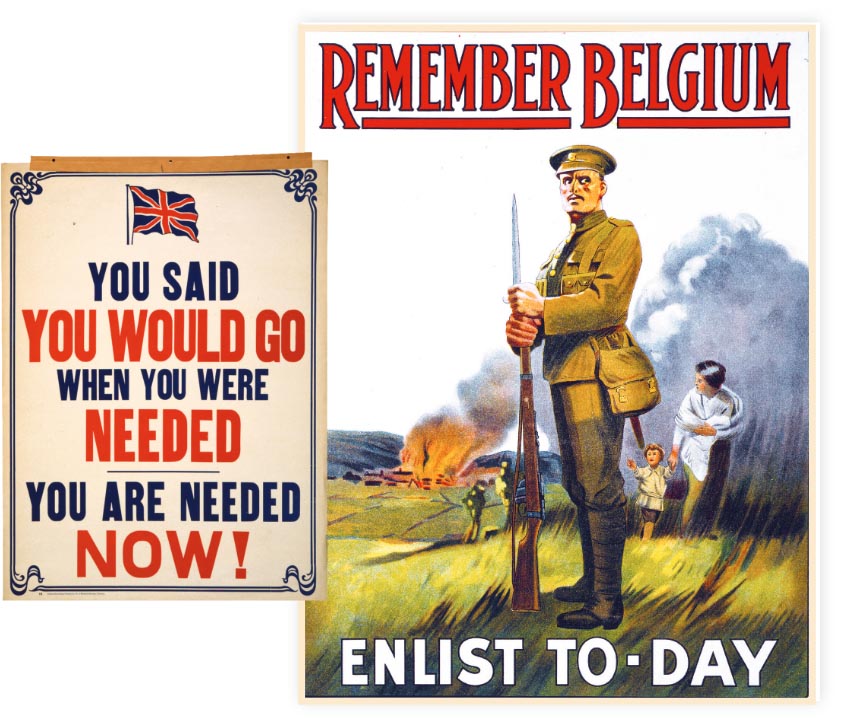
ABOVE
RALLY CRY
Canadians, many of them born in Britain, were motivated by loyalty to the Mother Country, but also by outrage over Germany’s aggression.
(Shawshots/Alamy/HH4MXP;Reid D. Smithy/LAC/3192697)
Canada, as a dominion of the British Empire, went to war when Britain went to war on Aug. 4, 1914. But it was Canadians who would decide the extent of their commitment. Standing by Britain was the primary factor in drawing Canadians into the ranks, but there were other impulses too, not least the outrage over Germany’s invasion and occupation of Belgium and France.
Stories of hardship and atrocity were amplified by propaganda, but there was a core truth that from late 1914 Germany was occupying 20 per cent of Belgium and about five per cent of France, including two million people in the northeastern section. Under such conditions, with Germany as a great power smashing its neighbours and occupying lands of Western allies, it is not surprising that Canadians were motivated to action.
There is clear evidence that Canadians were motivated to serve—to leave behind their homes and loved ones—and to fight far from their shores to liberate the French and Belgians.
But this story has been cast into the dustbin of history, even though, in the final five weeks of the war, the Canadians liberated more than 70,000 French and Belgian citizens and freed more than 200 cities, towns and villages.
“It made one feel that all this fighting had been worthwhile to see a people so glad to be delivered from hard rulers,” wrote Private William Davidson of the Canadian Field Artillery on taking part in the celebrations in Mons, Belgium, after victory.
This is the forgotten story of the Canadian liberators of 1918 who sacrificed and endured to return freedom to the oppressed.
LEFT
HOMEWARD BOUND
Soldiers of the Royal Canadian Regiment hang onto a ladder aboard RMS Adriatic as they depart Liverpool, England, on March 1, 1919.
(CWM/19940003-362)

anada went to war on Aug. 4, 1914. As a dominion of the British Empire, Canada was swept into this European conflict that would eventually explode into a world war.
While there were many reasons individual Canadians felt compelled to leave their homes and loved ones to serve, their motivations often included strong ties to the British Empire and a sense of duty in defending its ideals.
There were also those who were forced to go for economic reasons or who embarked for adventure. At the same time, many believed in the justness of the cause, especially in liberating the oppressed people of Western Europe.
As Canadian politicians and other societal leaders stoked the fires of patriotism, they almost always pointed to the German occupation of Belgium and France. The British and the Canadians both talked of standing up for little Belgium, citing the Kaiser’s contemptuous phrase that the treaty signed in 1839 guaranteeing Belgian neutrality was but a “scrap of paper.” The British people rebuked the Germans, spoke of honouring their commitments, and Canadians felt the same.
The 22nd Battalion (French Canadian) bids farewell as it begins its journey overseas in 1915.
(LAC/3194467)
MAPLE LEAF MEN
Canadian recruits, known as Maple Leaf Men for their maple leaf badges, arrive at a London station. When First World War veteran Conn Smythe bought the Toronto St. Patricks hockey franchise in 1927, he renamed it the Maple Leafs in honour of the soldiers with whom he had fought.
(Alamy/HH4MXP)
The invasion of Belgium and subsequent stories of atrocities, real and fabricated, also motivated Canadians to action. The burning of the Leuven library and its 230,000 irreplaceable books and manuscripts, the crimes committed against guerrilla fighters, the execution of some 5,000 partisans and civilians—all real—were mixed with fabricated stories of bayonetting babies and the mass rape of women and girls.
RUINS OF WAR
A street in Leuven, Belgium, lies in ruins (left). Curator Émile Théodore (right) of the Palais des Beaux-Arts in Lille, France, prepares pieces for evacuation in the face of German occupation in 1914.
(Bain News Service/George Grantham Bain Collection/U.S. Library of Congress/2014697569)
These atrocities were played up by the British and deliberately distributed in the papers of the Empire and the United States in the hope of enticing the Americans, but they drove many to action in Canada.
Dan McLellan of Grand River, P.E.I., felt obliged to enlist because of German oppression, writing that he preferred not to fight, “but when a peace-loving country is in distress and thousands of its peaceful, loving citizens driven from their homes by the unjust hand of Prussianism, could you ever forgive a son for being a traitor to those peace-loving people?”
RIGHT
TRIUMPH OF KULTUR
A 1915 recruitment poster shows the signatures and seals of the representatives of the Six Powers—Great Britain, Austria, France, the German Confederation, Russia and the Netherlands—to the Treaty of London (1839) guaranteeing the independence and neutrality of Belgium. Dripping with sarcasm, a 1914 Punch cartoon (right) by Bernard Partridge was designed to shock.
(Wikimedia (2); Historical Images Archive/Alamy/JE7K2C)
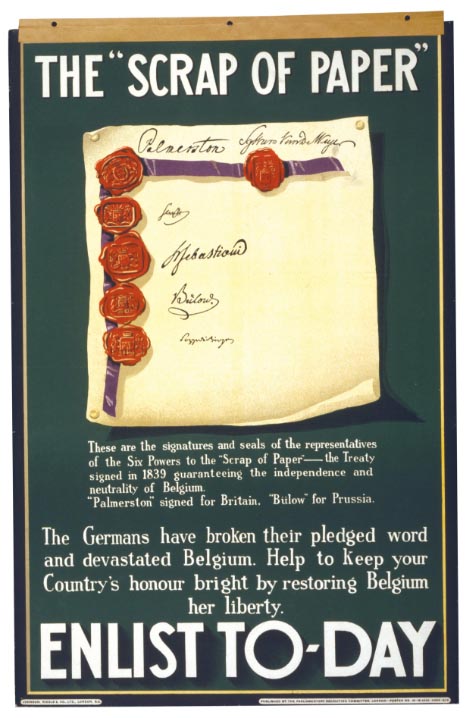
There was also widespread condemnation of German militarism, known by the common short-hand phrases of Prussianism or Kultur. Prussianism was linked to the Prussians, the most militarized state and class of Germans. Kultur was more amorphous, but it encompassed Germany’s militarized culture of soldiering and discipline.
Posters and art prints presented the visual story of the occupation, with the popular work of Louis Raemaekers’ displaced people and war refugees appearing in much-reproduced imagery throughout Canada. There were also popular prints, such as Frederick Henry Townsend’s “Bravo Belgium,” showing a resilient boy (Belgium) guarding a gate against a big, stronger and menacing man holding a club (Germany).
Even though the boy has no chance in the uneven fight, he will go down swinging.
RIGHT
THE LITTLE GUY
A Belgian farm boy stands up to the German aggressor in a political cartoon by F.H. Townsend in Punch on Aug. 12, 1914. “The Hun Ministry of Munitions,” comprised primarily of chemical and biological weapons, is depicted in a chalk cartoon by Louis Raemaekers.
(F.H. Townshend/Wikimedia; Louis Raemaekers/Wikimedia)

The Red Cross and other patriotic organizations drew on the idea of occupation to inspire Canadians to give money. The Canadian Patriotic Fund, established so that soldiers’ dependants would receive a supplementary income when they enlisted, turned to Western Europe as a warning. One poster, using only red and blue print and without a central image, shared the message: “Can I afford to pay for freedom / Belgium must afford to pay for slavery / Canadians can and must provide for families of those men who are saving us from Belgium’s fate / Subscribe now to the Canadian Patriotic Fund.”
Regimental posters that sought to draw young men to the colours used all manner of messaging, especially emphasizing honour, manliness and the need to serve king and country.
RIGHT
German soldiers cross fields in Belgium.
(Alamy/2AGH156)
RIGHT
A recruitment poster rallies the Irish.
(Wikimedia)
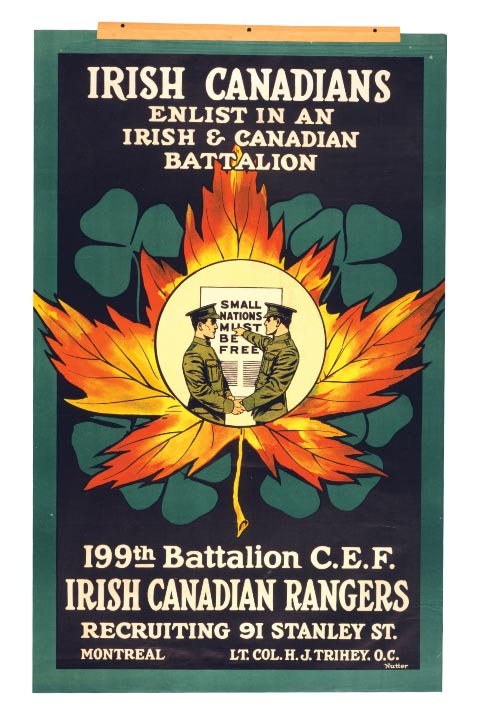
But portraying this war as a fight for freedom was also prominent. The 199th Battalion (Duchess of Connaught’s Own Irish Rangers)—raised in Montreal—displayed shamrocks and a maple leaf, along with the promise of Irish-Canadians serving together. But the central image of the rather busy poster showed two soldiers clasping hands and pointing to a sign that read: “Small Nations Must Be Free.” It was a direct reference to Belgium, using language that was commonly employed to describe the occupied country, but also a more subtle reference to Ireland.
The fight to free the oppressed of Western Europe stirred many to action. It was the primary cause for some, but more likely one of many emotional reasons that impelled Canadian men to leave their families and communities to go overseas. As French-Canadian soldier and future governor general of Canada, Georges Vanier, recounted, “I could not read the accounts of Belgian sufferings without a deep compassion and an active desire to right…the heinous wrong done.”
RIGHT
READYING FOR WAR
Mohawk soldiers serving on the Western Front line up for inspection.
(Everett Collection/Alamy/DD73D8)
Troops march during training at Valcartier, Que. The camp was established in August 1914 as the Canadian Expeditionary Force mobilized. Almost half the Canadians who enlisted in the CEF were born overseas.
(Bain News Service/U.S. Library of Congress/2014697490)
SLEEPING ROUGH
His weapon within reach, a soldier sleeps in a front-line trench at Thiepval, France, in 1918.
(National Library of Scotland/Wikimedia)
hile soldiers enlisted for many reasons, such motivations almost always faded rapidly in the face of the relentless slaughter on the Western Front.
The shock of the violence, the depth of the deprivation, and the unending strain in the trenches made the world small for most soldiers. They learned to survive by keeping their heads down and banding together with their mates.
Instead of the high ideals and big messages, the soldiers’ small units were crucial in keeping men fighting. Coercion, discipline and rewards bolstered morale. Over time, the soldiers, isolated from civilization and relying on one another, created their own unique fraternity, with strong regimental bonds, all sustained by a soldier’s culture of dark humour, songs, poetry, rumours and superstitions.
RIGHT
Artillery men rest in a hollow behind their guns near Boué, France, in April 1918.
(Harold Mowat/National Gallery of Canada/CWM/19710261-0431)
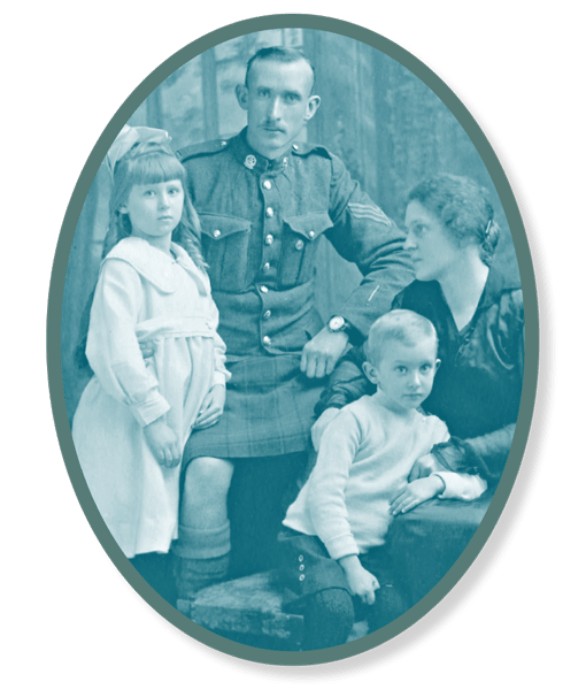
And yet, the liberating ideal persisted. Many employed it to justify why they had left their families to fight the Hun.
“Keep up courage Dear and don’t be afraid, and if it should happen that I do go under, I trust you will be proud that I have had the courage to get out and fight against such a domineering race,” wrote George Ormsby to his wife Maggie in his first letter from France. “Should Germany win this war then may God help Canada—in fact the whole world.”
Crippled in battle on the Somme, George returned to his wife and children and became a farmer in British Columbia.
Harold Henry Simpson wrote to his mother on his 20th birthday on March 17, 1917, saying that he still believed in the cause, despite months of fighting on the Western Front when so many of his comrades were killed.
“We have a stronger, nobler purpose leading us all in through the valley of pain and sorrow and sacrifice to the fairer and purer heights of the glorious attainment called an honourable and lasting peace, peace in which the autocrat no longer holds sway and which stands for the liberation of the oppressed and the downtrodden.”
AT WAR AND PEACE
George Ormsby with wife Maggie and their two children, Margaret and Hugh, and at the front in his Highland uniform, rifle in hand. He was gassed at Ypres in 1915, wounded by shrapnel on Hill 60 in 1916, and shot in the back at the Somme. He lived until 1967. The Canadian War Museum holds 177 letters written to and from Ormsby over the course of his service.
(CWM/20000013-011; 20000013-014; 20000013-001)
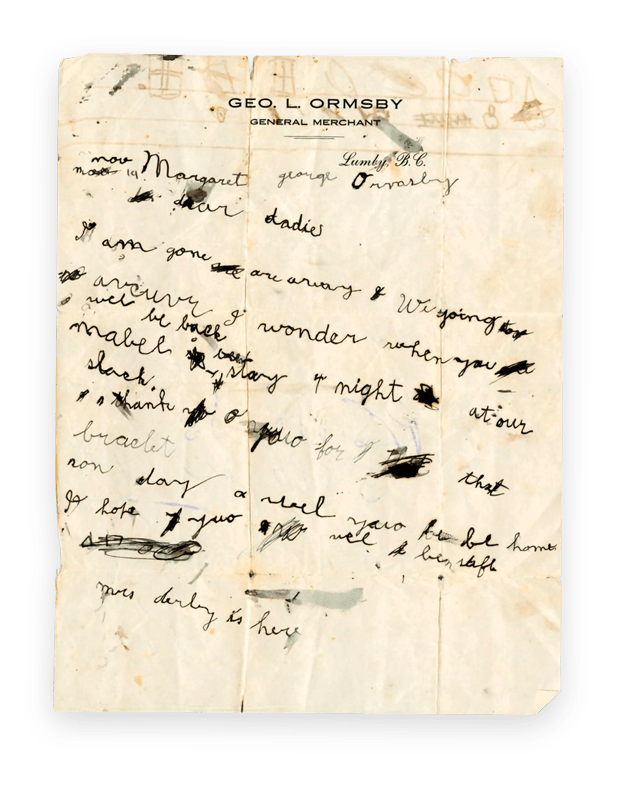
BAYONETS MOUNTED
Canadian troops train at Shorncliffe Army Camp in England in 1917.
(LAC/3404540)
William Antliff, a prewar student at McGill University, served in a field ambulance. He wrote his mother about the harsh reality of the front, but also what kept him in the fight.
“The newspaper talk about the cheerfulness & devil may care spirit of the Tommy under shell fire is pure bunkum but in spite of this I would sooner a thousand times die and lick the Boche than live under the Prussian tyranny. This isn’t any high-minded noble sacrifice principle but a matter of absolute existence. It is only by every man doing his bit we can win but we are going to win because we can’t afford to lose.”
Prussian tyranny was a reflection of the Kaiser’s militarized Kultur. Antliff—who survived the war—understood it through the cruel occupation of Belgium and France, and the suffering of the civilians.
“We all hope that this evil thing which the Allies are fighting will soon be exterminated, because we are of the most part tired of our European tour,” wrote Lieutenant F.G. Newton from Windsor, Ont., before the April 1917 battle for Vimy Ridge. Tired and worn-out, Newton understood the need to see the fight through to the bitter end.
Another Canuck, Private Richard May, wrote to his mother, “If you could see the hardships and suffering endured by the brave women and children of this unhappy land where so many homes have been ruined, you would not want us to return until victory has been won.”
May knew that his absence hurt his family, but he asked them to pray “that this high and holy vision may never fade from our minds, and that we may be given courage and patience to finish our task.” It was indeed a high and holy mission, and one that May believed was worth the terrible cost in lives.
The gift of freedom had to be returned to the persecuted civilians before he or Newton, or the many other Canadians far from home, could return to their loved ones.
he Canadians had been bloodied during the Second Battle of Ypres in April 1915, where they had faced overwhelming German forces and endured the unleashed chlorine gas.
At the cost of some 6,000 casualties over several days, they had fought valiantly and forged their reputation in the fields of Flanders, with their desperate defence heralded throughout the Empire.
Other battles followed—at Festubert in May 1915, Saint Eloi in April 1916, Mont Sorrel in June 1916—as well as the grinding trench warfare across the front. The cataclysm that was the Battle of the Somme raged from July to November 1916. It was followed by tactical reforms and refined artillery tactics that led to the stunning victories of 1917.
First was Vimy, where the seemingly impregnable ridge was snatched by the Canadians in April. Next was the innovative smashing of the Germans at Hill 70 in August. Then was the hard-fought victory amid a sea of mud and unburied corpses at Passchendaele in October and November 1917.
ALL ABOARD
Soldiers of the 5th Battalion, Canadian Mounted Rifles, aboard a Mark IV tank after the victory at Amiens, France, in August 1918.
(LAC/3405524)
These three victories, paid for in blood, confirmed that the Canadians were shock troops who delivered victory in the toughest of battles.
Under command of Canadian-born General Arthur Currie, the Canadian Corps was prepared to defend against the German attacks from March 21, 1918, that restored mobility on the Western Front. German Sturmtruppen (assault troops) drove through and around British forces, capturing and killing tens of thousands and throwing the Tommies into temporary retreat.
After a fortnight of grim defeats, the Allies recovered from the stunning blow and then slowly ground out the enemy offensive, killing in shocking numbers the fast-moving German infantry who were increasingly distanced from their artillery.
“It’s so much easier killing him when he comes over and less costly in every way,” wrote Lieutenant Armine Norris, a machine gunner. Norris was slain in combat later in the year.
RIGHT
BOMBS AWAY
A propaganda postcard issued by Köhler Druck in Germany under the title Frontbilder 1918 (Front images 1918) depicts German troops tossing grenades, or ‘bombs’ as they were known at the time.
(Elk Eber/Köhler Druck/Wikimedia)
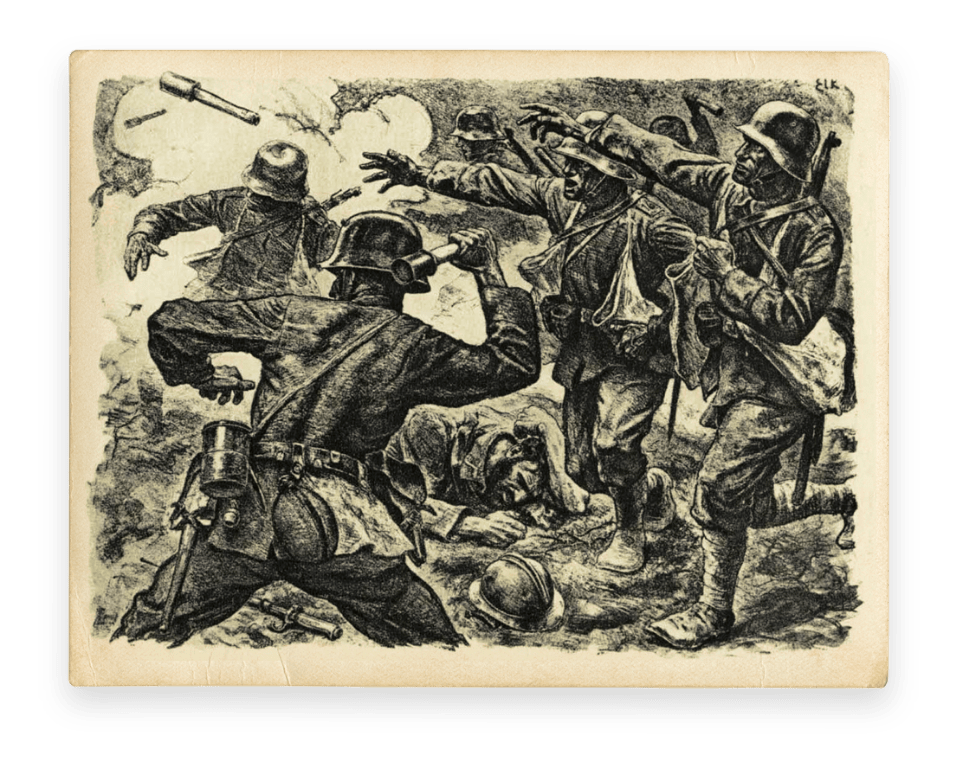
German soldiers advance into Bailleul, France, during the 1918 Spring Offensive.
(Chronicle/Alamy/DRDDBE)
The French, Americans and Australians counterattacked the depleted Germans in several battles in July 1918, and the Germans, weakened by the flu pandemic and having lost more than 800,000 soldiers from March, gave ground. In August, it was the Allies’ turn to strike back.
Douglas Haig, commander-in-chief of the British Expeditionary Force, grouped two of his best formations—the Australian and Canadian corps—to spearhead an attack at Amiens. The secret operation, which brought hundreds of thousands of infantry and more than 600 tanks to the battlefield east of Amiens, struck a mighty blow to the Germans. This victory started the Hundred Days campaign.
Canadian participation in the Hundred Days campaign was the most important and impressive contribution to the Allied victory. The Canadian Corps defeated elements of 47 German divisions, or roughly a quarter of the German army.
WASTELAND
Troops move into position on the battlefield near Arras, France, in August 1918.
(Detroit Publishing Company/U.S. Library of Congress/2016816230)
The four Canadian divisions, with occasional British formations attached to Currie’s corps, fought at Amiens and then moved to the Arras front near Vimy Ridge, where it spearheaded another attack at the end of August.
In desperate fighting, the Germans were beaten again, and the Canadians, despite having lost more than 25,000 killed and wounded in the two titanic campaigns, launched a third operation at the end of September to cross the Canal du Nord and capture Cambrai.
From Sept. 27 onward, the Canadians stormed the enemy lines, fighting day after day, advancing, digging in, holding off enemy counterattacks, and driving forward again into the teeth of enemy defences. The cost was witheringly high.
RIGHT
Allied tanks advance through the congested ruins of the French village of Hourges during the Battle of Amiens in August 1918.
(LAC/3395394)
But the battle-hardened Canadians shattered the enemy defences. Cambrai, a key logistical city, was critical to the entire German line and the soldiers had been ordered to hold it at all costs.
In desperation, the Germans threw new divisions and machine-gun companies into the line, but the Canadians would not be denied. Cambrai was captured in a final push on Oct. 8-9. More than 12,000 Canadians were killed and wounded, for a total of almost 43,000 since Amiens.
The Cambrai battles were “the bitterest fighting we have ever experienced,” Currie recalled. “It was attack and counterattack every day.”
If victory at Amiens was the beginning of the end, Cambrai was almost the end of the end. Driven from their crucial logistical centre, the Germans were broken. The British naval blockade had choked off supplies and food, and tens of thousands of starving Germans were succumbing to the deadly influenza that was sweeping the world, destined to kill some 50 million people.
DIRTY WAR
Canadian officers inspect captured German guns, battle-damaged during the advance on Cambrai.
(LAC/3397965)
Germany’s primary allies, Austria-Hungary, Bulgaria and the Ottoman Empire, were on their last legs and facing certain defeat along the many fighting fronts. And on the primary battleground, the Western Front, the Kaiser’s armies were steadily defeated.
The capture of Cambrai was the crowning event for the Canadian Corps, with three major victories since Aug. 8. Even with reinforcements and conscripts, the cost had been severe.
“We didn’t have a skeleton of a battalion left when I come out of the line,” recounted infantryman A.W.W. Kyle. “I had five bullet holes on my equipment and uniform. I had bullet holes in my water bottle, I had them through the arm of my coat. I had them through the skirt of my coat. I had a bullet in the sole of my shoe from these machine guns, but I never got a scratch.… It was a miracle.”
RIGHT
WATCH YOUR STEP
A soldier stumbles as Canadians advance through a German barrage east of Arras in September 1918.
(William Rider-Rider/LAC/3194820)
Most of those who fought at the sharp end could scarcely believe that they had survived. Others were angry at the loss of life. The Canadians had been pushed too hard, they thought, and asked to do too much.
Corporal Albert West was furious with the idea that the Canadians had to keep fighting.
“In Heaven’s name, surely we handful of men (and so few officers) are not to be put thro’ the mill without more reinforcements,” he wrote on Oct. 9, 1918. “We need 400-500 men at once.”
Bruised and battered, angry and worn out, the Canadians also held a collective sense of pride.
“The chance of peace seems good but I hope that we really smash him up,” Andrew McNaughton, an innovative gunner and a general in the next war, wrote a few days after Cambrai.
Canadian snipers at Beaurains in 1918 , depicted by Alfred Bastien.
(Lieut. Alfred T.J. Bastien/CWM/ 19710261-0055)
FOR YOU, THE WAR IS OVER
German prisoners line up after being captured in Belgium on June 8, 1917.
(Ernest Brooks/George Grantham Bain Collection/U.S. Library of Congress/2014705068)
With the Germans fleeing eastward, the Canadians began to follow, seeking to close with the enemy, and perhaps, as McNaughton noted, to “smash him up.” These were soldiers who did not know that the war on the Western Front would end on Nov. 11. And so the Allies continued to press the enemy back.
The weather had turned cold, the wind biting, and rain swept the snaking ranks of marching soldiers that stretched back for kilometres, along every road leading from west to east. In mid-October, the Canadians moved away from Cambrai in greater numbers, advancing on a wide arc, with the 1st and 2nd divisions in the lead.
“The Germans were falling back everywhere,” wrote Currie in an official report describing this phase of the operation.
To buy time for the retreating forces, German commanders ordered strongpoints of sacrificial snipers, machine-gun units or the occasional mortar team to hold up the Allied forces. When the bullets cut down Canadians in the lead, it took time to order forward sections to advance in rushes or to call back to the artillery, also on the move, to lay down a crushing fire.
HEAVE-HO
Canadian troops push a truck along a muddy and heavily bombed road in April 1917.
(The Print Collector/Alamy/BJW9GT)
These German ambushes took a daily toll on the Canadians, adding to the misery, anger and loss of life.
“We had advances of several kilometres…in pursuit of the Germans, taking quite a number of prisoners and machine guns,” wrote infantryman R.H. Hunter. “They were all machine-gunners left behind to delay our advance and allow the main bodies of his troops to retire.”
In addition to these sacrificial forces, enemy combat engineers laid waste to the countryside. Logs blocked roads, bridges were demolished, and explosive charges cratered roads. The engineers of the 3rd Canadian Division filled 135 road craters. The “wholesale destruction of road and railways” further slowed the pursuit, wrote Currie, as did the tearing up of all rail lines, light and heavy.
RIGHT
A soldier is depicted triggering a booby trap in a stereoscopic postcard image.
(LAC/3194798)
“During the entire advance,” wrote Major Horace Singer of the 31st Battalion, “the Canadian engineers did splendid work, repairing roads and bridging gaps so speedily that the artillery and immense supply columns were able to keep well up to the infantry.”
As the engineers built and rebuilt the infrastructure, the infantry kept up aggressive patrolling, much like the Australians had pioneered throughout 1918, which they called peaceful penetration.
Some patrols were annihilated by German rearguard forces that ambushed them, but often the Canadians took the enemy unprepared, destroying them or forcing their surrender. Every day, dozens and sometimes hundreds of German prisoners were sent to the rear.
“Fighting here has changed completely to what it was two or three years ago,” wrote Lieutenant R.D. Borrette in mid-October, marvelling at the true open warfare. This was a different phase of fighting from that of the hard-pounding attacks of the three set-piece battles of the Hundred Days, with their timetable assaults still tied to the artillery in a type of semi-open warfare.
RAILROADERS
Engineers lay railway tracks at Ecoust, France, after the Battle of Drocourt-Quéant Line on Sept. 6, 1918.
(Bain News Service/U.S. Library of Congress/2014708054)
Now, marching through farmers’ fields, the Canadians were amazed to see the area largely undamaged by shellfire, save for the deliberate German obliteration. The trees were unscarred and turning beautiful shades of red and orange. This, too, signalled to many infantrymen that this was a new phase of operations, and it reminded many homesick soldiers of Canada.
The Canadians advanced into a heavy fog on the morning of Oct. 18. There was a worry that the enemy might turn and strike, aided by the miasma, but the Germans kept retreating. That day was also important because—with the 1st and 2nd divisions in the vanguard—they freed many French towns, including Férin, Courchelettes, Gœulzin, Villers-au-Tertre, Cantin, Roucourt, Brunémont, Aubigny-au-Bac, Féchain, Fressain, Bugnicourt and Hem-Lenglet. An additional 12 villages and towns were also liberated.
HARDSCRABBLE LIFE
A French family pauses outside their wooden shack during the First World War. Dozens of French villages and towns were damaged or destroyed in four years of fighting.
(Bain News Service/U.S. Library of Congress/2014706743)
“The people could not do enough for us,” reported the war diarist of the 4th Brigade, Canadian Field Artillery, describing the joyful reception of the liberated. “Every time the column halted, cups of steaming hot coffee and biscuits were handed to the men, and our horses were garlanded with flowers.”
To further delay the pursuing Canadians, the Germans also laid a number of booby traps. “He had not the time necessary to destroy the town, but he had shown his petty spite by wilfully doing all the damage he could to the contents of the houses, and he had left some of the damnable ‘booby traps,’” wrote Sergeant L. McLeod Gould of the 102nd Battalion. “An artilleryman in Auberchicourt was blown to pieces by a bomb hidden in a piano which exploded when the first chord was struck.”
Rumour mills spread and amplified the effects of these hidden bombs, even though they were far less deadly than conventional shellfire or bullets.
French civilians tried to help their liberators, pointing out where bombs might be placed, in which direction the Germans fled, and by helping read maps (the Germans invariably tore down all signposts).
MERCI, MES AMIS
Residents of Saudemont, France, thank members of the 4th Battalion, Canadian Mounted Rifles, after being liberated from four years of German occupation.
(LAC/3397405)
The Canadians plunged onward. More often, from mid-October on, it was grey, not sunny; cold, not warm. Men went to bed wet from sweat and rain and woke up clammy and feeling ill.
On Oct. 19, after a day of steady marching some 12 kilometres, the longest single-day drive of the war for the Canadians, the steamroller advanced on a wide front and liberated another 40 settlements.
The largest was the industrial town of Denain, on the north bank of the Canal de l’Escaut. Denain was an important city to slow the Allied advance, and the Germans defended it fiercely, fighting amid the terrified civilians. But they could not hold it against the Canadians, who drove them back, killing and capturing hundreds.
As the lead units pushed on, the French in Denain and the smaller settlements around it emerged to thank the tired Canucks.
“Coffee, cognac, kisses and hugs were showered on the troops by the populace who were frantic with joy after having suffered four years of slavery under the ruthless rule of Hun masters,” wrote the war diarist for a Canadian battalion on Oct. 19.
Citizens of Denain sang out in praise and posted banners that read “Vive les Canadiens,” “Glory to the Heroes” and “Long Live the Liberators.”
Beyond Denain, the Canadian front narrowed, with the 2nd Division slipping into reserve as the 4th Canadian Division and 51st British Division moved into the lead. On Oct. 20, additional large settlements—Hasnon, Wallers and Haveluy—were all freed, with several thousand citizens greeting their liberators.
Private Victor W. Wheeler, who enlisted at age 19 from Calgary and served as a signaller at the front from August 1916, remarked on the systematic destruction by the Germans. And yet he also noted how hundreds of civilians emerged to cheer on the Canadians. His platoon was swarmed by them, “liberated after four years as captive, they were wild with joy.” The muddy soldiers were hugged and kissed, and the French offered up their homes as billets.
LEFT
A French girl walks hand-in-hand with Canadians through the flooded streets of Valenciennes, France, in November 1918.
(LAC/3397417)
WARM RECEPTION
Lieutenant-General Arthur Currie (below, from left), Edward, Prince of Wales and major-generals Edward W.B. Morrison and David Watson attend a Thanksgiving service and reception in Denain, France, on the day after the town was liberated—Oct. 19, 1918.
(DND/LAC/3522373)
By Oct. 22, the Canadians had liberated another dozen settlements, with some units reaching as far as the Scheldt River. On the other side of the river was the large French city of Valenciennes. The Germans had flooded the area and Currie knew that his soldiers would likely face a stiff battle if British forces opposite the city could not capture it.
Currie’s corps slowed its advance because of the terrain and because British formations were ahead of it. At the same time, a logistical famine was also affecting the drive eastward, as the supply wagons and railheads were left far behind. Food and water were slow to arrive to the forward units of the corps—which was equivalent in size to one of Canada’s larger cities, albeit filled with homeless people and suffering a frighteningly high homicide rate.
From Oct. 14 to 22, there had been steady marching and fighting with the Germans, but as the enemy fled back to Valenciennes, the tempo of operations slowed. Most of the Canadians remained far in the rear, in a pattern that saw them billeted in the dozens of French villages and towns throughout the freed area. This became a period of sustained recuperation and mingling with the grateful French.
As the first Canadian units passed through the French settlements, they were greeted by cheering crowds, offered flowers, wine and other fortifying drinks, but they continued on with the march toward the ever-retreating enemy.
It was a different experience for the follow-on units that did not face enemy snipers or shells from the cleared areas. The French, too, became more certain of their freedom. It did not seem like the liberators would be driven back in a counterattack, casting the French into servitude again. They became more certain of their freedom.
“To our surprise,” wrote a Canadian gunner from the 43rd Battery, Canadian Field Artillery, “as we entered one town, lights were to be seen here and there and we heard scattered cheers and women’s voices. It was probably the greatest moment of the war as we passed down the street, the women, old men and children yelling themselves hoarse and waving long-hidden flags.”
LEFT
A nursing sister and surgeons of No. 3 Canadian General Hospital treat soldiers (below) in a church in Doullens, France, in a painting by Gerald Moira. A German aircraft dropped bombs on the church on May 29-30, 1918, killing 32.
(Gerald Edward Moira/CWM/ 19710261-0427)
JOY AND CARE
Citizens of Valenciennes, France, welcome their Canadian liberators.
(LAC/3397434)
The greatest moment, indeed. As thousands of Canadians moved past the cheering crowds, they could see the tangible effects of their actions.
“It was the first time they had ever really felt like ‘heroes’
and ‘saviours of democracy,’” wrote the regimental historian of the 15th Battalion. While the combat-hardened Canadians were worn-out and dead-eyed, with blistered feet, wind-burnt faces and packs that felt like they were filled with bricks, the sight of cheering people waving flags raised their spirits.
The Canadian infantry had a chance to practise their own French, and the 22nd Battalion (French Canadian) was joyfully received by the locals. Songs were also sung back and forth, an easier way to communicate for many of the English Canadians. The French belted out “La Marseillaise,” “La Brabançonne” and versions of “It’s a Long Way to Tipperary,” while the Canadians loosened up their throats with countless marching songs of drink, women, adventure and other dirty ditties that had to be modified in the presence of civilians.
Kenneth Walter Foster was a prewar elevator operator in Victoria before enlisting in 1915 and serving throughout the war as an infantryman, machine gunner and runner. He had come through the trial of the Hundred Days with the 2nd Battalion. He wrote of being part of the Canadian forces that brought freedom.
“The liberated French people who had been held prisoners for more than four years were overwhelmed with joy at the sight of the Canadian troops,” he wrote. “They shouted triumphantly “Vive les Canadiens!”
Accompanied by a French boy, soldiers of the 8th Battalion, the King’s Regiment (Liverpool) enter Lille, France, on Oct. 18.
(LAC/3397053)
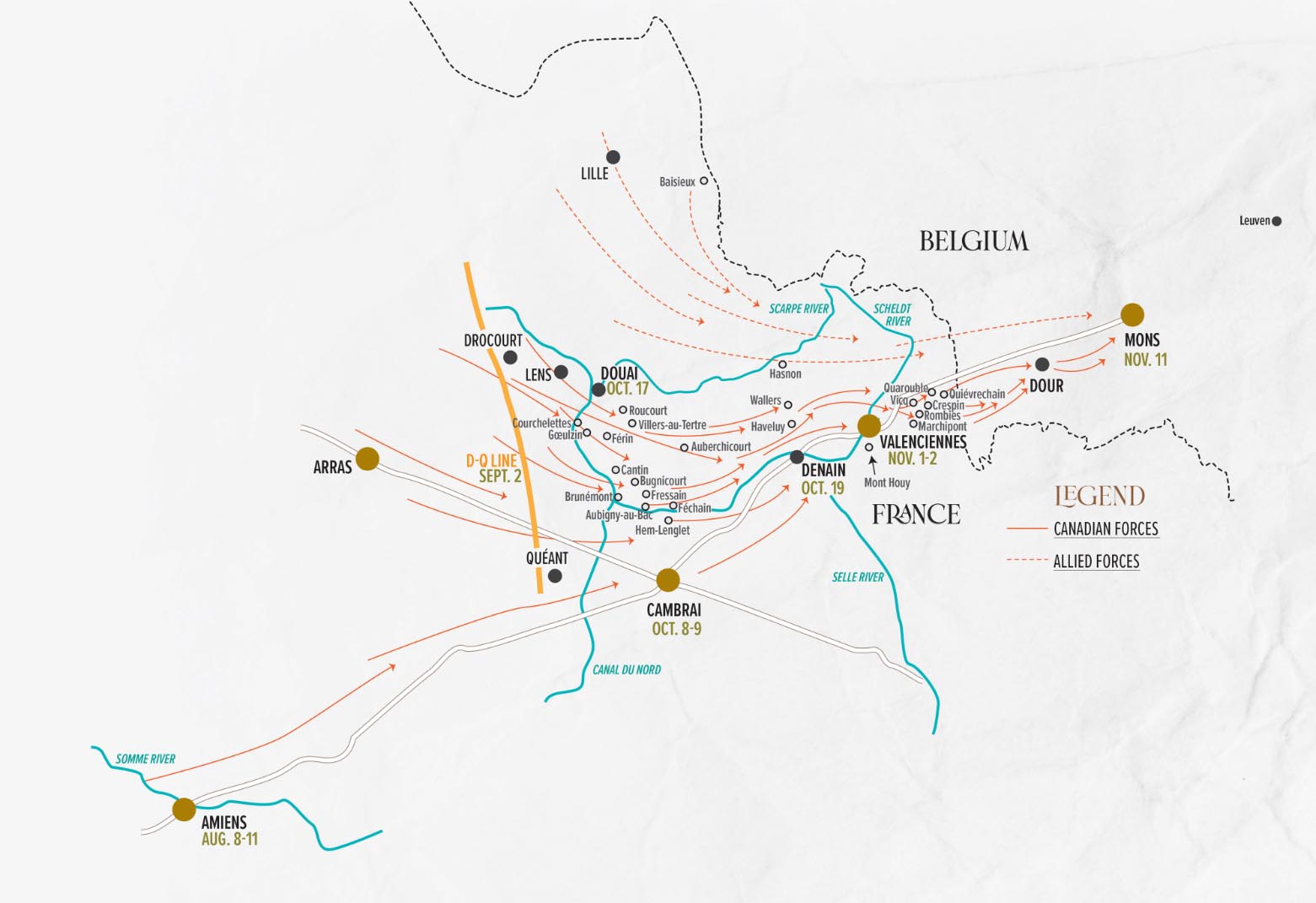
Gas-masked Canadian stretcher-bearers bring in wounded from the Battle of Amiens in August 1918.
(Bain News Service/U.S Library of Congress/2014708135)
efore the staggering victories of the Hundred Days campaign, no one in the Allied high command thought the war would end in 1918. The Germans were being squeezed hard through the naval blockade and the pandemic was beginning to reap its countless victims, but the fighting forces on the Western Front seemed able to withstand any blow.
So the Allies planned to strike back at Amiens, finish the fighting season with that limited victory, and finally defeat Germany in 1919, with the American Doughboys in the lead. Three converging operations would form the large-scale offensive.
The first was the heavy use of chemical weapons in dense and relentless discharges. The naval blockade had created shortages of rubber and charcoal for German respirators, and captured copies had revealed to the Allied scientists that many were of a sub-standard type. Massed gas concentrations of phosgene, chlorine and other chemicals would overwhelm the respirator filters and lead to grievous casualties.
LAND AND AIR
British Mark V tanks, first deployed in 1918, advance near Cambrai during the Battle of St. Quentin Canal.
(De Luan/Alamy/2B9WNR8)
Second, there would be increased aerial attacks on enemy communication lines and cities in a strategic bombing campaign. While the Germans had started indiscriminate aerial bombardment in 1915 with Zeppelin attacks, and continued with fixed-wing aircraft, the Allies had built up their forces of twin-engine bombers to take the war to the enemy’s rear supply areas and even urban centres. This wasn’t much compared to the bombing campaigns of the Second World War, but it was the continuation of a trend of striking deep into enemy territory in a war against infrastructure and citizens.
Finally, the plan was to unleash a massed tank force to break a hole in the enemy lines. It would include many newly produced tanks, including the wider-tracked Mark VII and the heavier Mark VIII. There would be frontal assaults and flank attacks with the goal of breaking through the front lines and causing havoc in the enemy’s soft underbelly.
These three operations, along with the now-honed Allied combined-arms doctrine of artillery, infantry, engineers and other combat arms working together that had been crucial to the tactical victories of the Hundred Days, were all part of the plan to end the war in 1919.
FOG OF WAR
German infantry (below) train for a gas attack somewhere behind the Flanders front in 1918.
(Scherl/Süddeutsche Zeitung/Alamy/C45BHF)
RIGHT
Aircraft of No. 1 Squadron, Royal Air Force, in France, ready for action shortly after the RAF was formed on April 1, 1918.
(LAC/3390900)
elirious with joy” was how Will Bird, an infantryman with the 42nd Battalion (Royal Highlanders of Canada), described the liberated French who “lined the road and waved at us, and the children ran alongside crying ‘Bon Canadaw.’”
Yet amid the celebrations throughout the Canadian Corps’ zone of liberation, there were also roads clogged with the pitiful sight of refugees returning home after years of having their farms and dwellings occupied by German soldiers.
It was a trudging procession of returnees. Carts were piled high with possessions, some with a toddler sitting on top like a cherry.
Many had no shoes and their bare feet were wrapped in rags. Their clothes were threadbare and ragged, and often they wore several layers for warmth to fend off the late-October cold. And despite the adversity, many were hoarse from thanking the liberators for giving them back their homes.
WAITING FATE
Refugee children in 1918 Paris wait to be taken to Grand Val, a country estate staffed by the American Red Cross. At least 10 million people were displaced during the war.
(American National Red Cross Collection/U.S. Library of Congress/2017667837)
Watching the weary civilians, one Canuck believed that “the hardships of the last three or four years seemed to us to have been well worthwhile.”
“Steady stream of civilians coming down from Denain all day yesterday and today. Very pitiful sight in many cases,” wrote gunner Bert Sargent on Oct. 21, 1918. “The old Boche sure is foxy. He strips them of everything except their clothes, knowing we will have to feed and look after them.”
Currie’s troops freed tens of thousands of French civilians during this two-week period in late October, but Germany’s scorched-earth policy had left almost all the refugees hungry and in need of medical aid. With food for the fighting forces in short supply and logistics stretched to the breaking point, there was the added strain of having to feed and provide medical care to tens of thousands.
“Over 200 civilians are sick, about 15 of them have died in the last three days from consumption, starvation, and ill treatment from the Huns,” wrote Major T. Edgar MacNutt, a long-service veteran from Prince Edward Island.
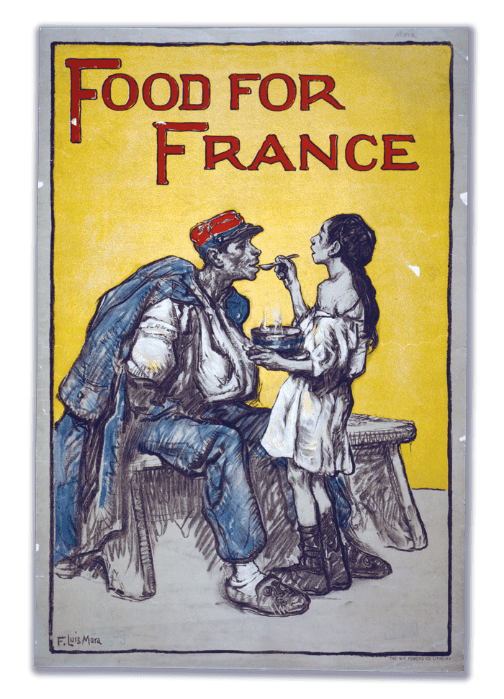
DESPERATE STRAITS
Refugees move along a road near Ypres, Belgium. A girl feeds soup to a wounded soldier in a wartime poster, one of many methods used to rally support for the Allied cause.
(Chronicle/Alamy/DRHWHR: LAC)
The Canadian Red Cross pitched in, rushing forward with portable kitchens and dispensing canned food, biscuits and loads of Bovril. These non-combatants were so zealous they often raced into the zone of shellfire, setting up coffee stalls before being ordered back by infantry officers who did not want their blood spilled by German shells or snipers.
Doctors, nurses and orderlies of the Canadian Army Medical Corps also followed right behind the fighting units, setting up new hospitals along the front. These were staffed with the latest medical equipment, including X-rays and blood-transfusion kits. There were also dressing stations to focus on the civilian population, who were suffering from all manner of ailments and disease brought on by the cruel occupation.
At war’s end, Canadians held the easternmost point on the British sector of the Western Front, at Mons, Belgium, where British troops fought, and lost, their first battle in 1914.
(F. Luis Mora/W.F. Powers Co./U.S. Library of Congress/2002719771)
PANDEMIC 1918
The battlefields behind them, influenza patients fight for their lives at U.S. Army Camp Hospital No. 45 in Aix-les-Bains, France. More Americans died from influenza than were killed in the First World War. Estimates put global mortality in the 1918-1919 pandemic at 30 to 50 million.
(Science History Images/Alamy/HRKPKN)
However, a new killer was sweeping through the population, passing from one sick person to the next.
The Spanish flu, as it came to be called—not because it originated in Spain, but because neutral Spain had reported on it first in early 1918—was lethal and terrifying. The first wave of the H1N1 virus had run through the Canadian soldiers in May and June 1918, and it brought great sickness, with weakness, deep coughing and fever, but, for the most part, it did not kill. Sometime in the late summer, the virus mutated and tore through the armies on the Western Front, and then around the world.
The German forces had been badly weakened by the flu during the Hundred Days campaign, as were all armies and countries, but the Canadians began to witness the devastating effects in October.
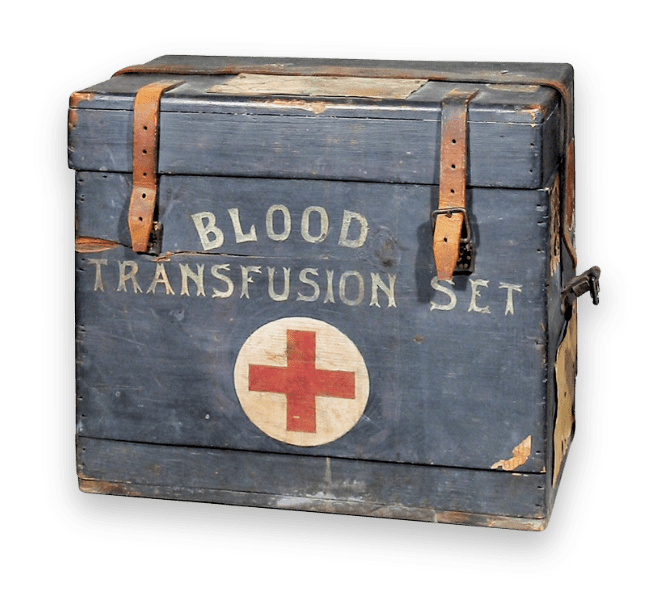
EMERGENCY MEASURES
A Canadian Red Cross ambulance carries wounded to hospital from the Gare de la Chapelle in Paris in July 1918. A portable transfusion kit used by pioneering Canadian doctor Norman Miles Guiou.
(Wharton/American National Red Cross Collection/ U.S. Library of Congress/2017674643;CWM/19980102-003)
“We are in a very bad state here, owing to the plague that is sweeping England,” wrote W.J. Stares from the Canadian Reserve Battalion training camp at Seaford, England, on Oct. 21, 1918.
“Many deaths have occurred in Camp and every available space is now a Hospital.”
While flu victims were sent to hospitals where they were placed in isolation wards, there was still considerable sickness at the front. The flu eventually killed at least 776 Canadians in uniform overseas, as recorded by the Canadian Army Medical Corps, although it surely contributed to the death of other soldiers who were already weakened with gassed lungs or labelled as pneumonia victims.
Alfred Bastien’s painting depicts a field dressing station at Arras in 1915.
(Alfred Bastien/CWM/19710261-0089)
“The men are enjoying themselves immensely. It is something new to move forward into a town full of civilians and have them greet you with flags and other tokens of enthusiasm,” wrote Cyrus Inches, a lawyer from Saint John, N.B., who who commanded the 1st Canadian Heavy Battery. He also told his brother, “The civilians have an intense loathing of the Hun.”
That intense loathing was also embraced by the Canadians who, amid the celebrations and bonhomie with the French, heard in more detail about the cruel German tactics. The effects of the occupation could be seen in the hollow eyes and emaciated faces of the French, and it was not surprising to Canadians to hear that the Kaiser’s forces had subjected the occupied civilians to a reign of terror.
THE COST
The war is over and a French village lies in ruin. A priest reads the funeral mass over a trench filled with French dead.
(American National Red Cross Collection/U.S. Library of Congress/2017684718 ; U.S. Library of Congress/92515229)
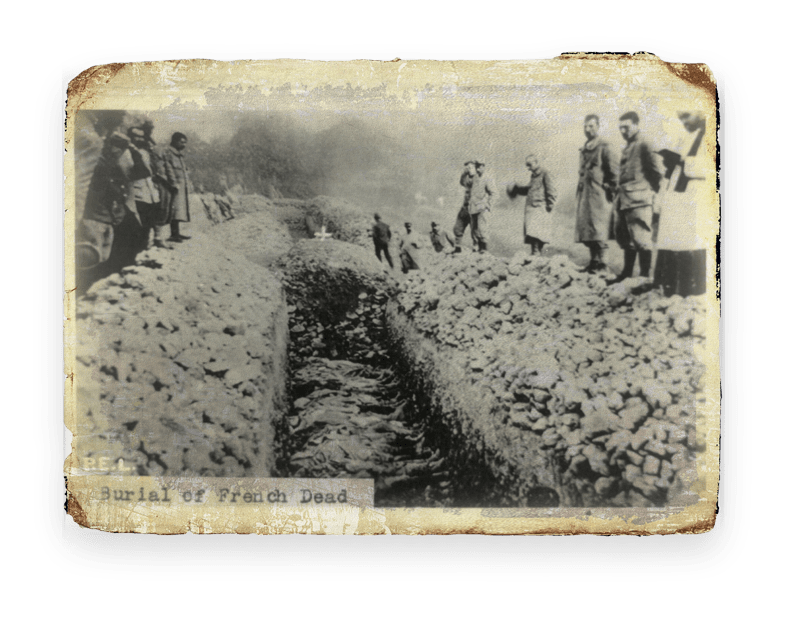
The French also showed their liberators gravesites of civilians who had been executed by the Germans over the past four years, or more recently as they retreated back to their border.
Along with the stories of atrocities, a steady stream of British and Canadian prisoners drifted into the Canadian lines. These were men who had been captured in the see-saw battles of the previous weeks, especially in the fighting on the outskirts of Cambrai. They had either been on the run and protected by French farmers or they were prisoners who had recently slipped away from their captors.
“Walking skeletons, with matted hair and beards, rags tied around their feet in lieu of boots, their clothing crawling with vermin,” a Canadian infantryman wrote of the prisoners. “Seeing them so weak-voiced and pitiful made us furious, as all of us had seen German prisoners in England well-fed and well-housed.”
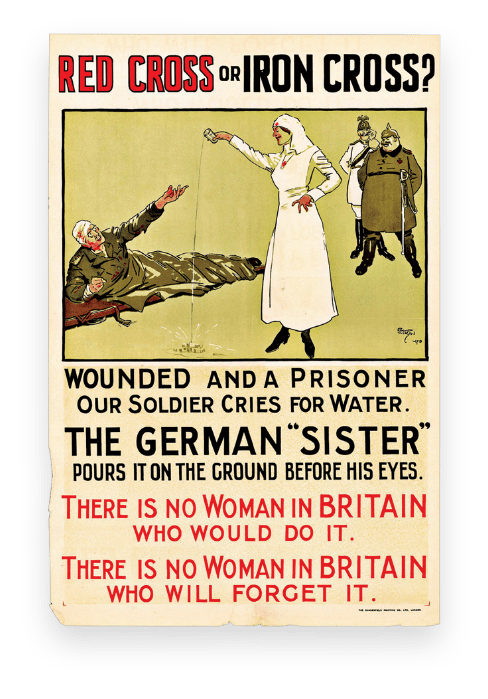
The Canadians pooled their food and money to buy extra bread for them from the local villagers, and the freed soldiers hobbled on to medical care.
Harold Henry Simpson, an infantryman who was awarded the Military Medal, wrote to his mother of the sights and experiences, summing up the liberation period since Cambrai had fallen.
“The last six weeks so full of new and wonderful experiences have passed very quickly but they will always remain a sad but pleasurable remembrance, sad because of untold suffering with which we have come in contact, suffering of homeless refugees, widows and orphans made destitute by the war.”
LEFT
PROPAGANDA WAR
The 42nd Regiment (Royal Highlanders of Canada) moves up for the early-morning attack on Cambrai. A British propaganda poster depicts a wounded prisoner of war being deprived of water by a German nurse.
(William Rider-Rider/LAC/3355935; University of British Columbia Library/Wikimedia)
DOWN THE LINE
Civilians flee danger while soldiers move toward it in Marcoing, France, on Nov. 22, 1917. Those seeking refuge have come from the village of Noyelles, 60 kilometres away. The industrial centre of Lens, where coal was discovered in 1849, was reduced to ruin. German troops flooded the mines and razed 10,000 workmen’s houses under a scorched-earth policy.
(Science History Images/Alamy/HRP0PA)
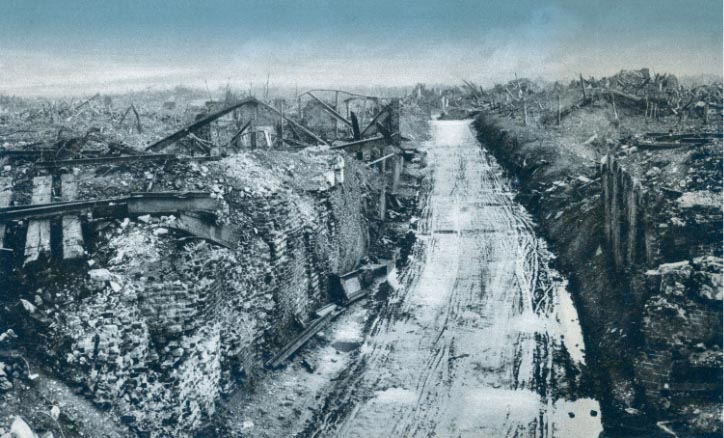
Simpson was particularly moved by the plight of civilians, but also the generous care offered by his fellow battle-hardened combatants. They had lived and survived through awful violence, and yet they had not lost their humanity.
Simpson had taken shelter in a cellar with an 82-year-old grandmother, her daughter and her four children, as long-range enemy shells crashed down into a newly liberated village. During the bombardment, the civilians were crying and whimpering, and the soldiers offered sympathy and soothing words.
He noted to his mother that they were just some of the many civilians who were making tremendous “sacrifices” for their country, and save for those moments of terror, they were usually cheerful and grateful to the Canucks. They were “people liberated from hell on earth.”
RIGHT
CLOSE CALL
A newly widowed father stands by as a Canadian soldier pacifies his baby near Mons. The child was in her mother’s arms when the woman was killed by an enemy shell.
(LAC/3194345)
he big Canadian general worked himself relentlessly. He suffered from poor health during the war as he slept little and worried continuously about his soldiers.
General Arthur Currie of Victoria, B.C., (he was born near Strathroy, Ont.) had served with the First Contingent in 1914 and was 41 when he became the first Canadian commander of the Canadian Corps. Journalist J.F.B. Livesay, one of few Canadian Press journalists at the front, was surprised to be invited to speak to Currie one day during the Hundred Days campaign. They talked briefly and the general showed him long lists of casualties.
WEIGHT OF COMMAND
A brigade commander at the outset, Arthur Currie took charge of the Canadian Corps in 1917. He oversaw some of the war’s fiercest fighting and took losses under his command to heart. As with most leaders, especially those of this war, his legacy is still debated.
(LAC/3191901; LAC/3522226; LAC/3521961)
“I saw in his face a story of tragic suffering,” wrote Livesay.
Needing a friend to talk to, and not willing to unburden himself on his subordinates, Currie shared his pain with the journalist, talking about the weight of command and of being forced to send the young into battle.
“His heavy body shook with sobs,” wrote Livesay. Within five minutes, the general had worked through the crisis, wiped the tears, rose and left to face the war, “again the grim soldier he had to be.”
Currie commanded one of the finest fighting formations on the Western Front, but he also knew that shock troops took heavy casualties and that there were no bloodless victories.
ince mid-October 1918, the many acts of liberation reinforced in the minds of Canadian soldiers that they were engaged in a necessary and just war.
All felt they had lost too many friends during the Hundred Days, and that they had suffered for too long on the Western Front, but the foot soldiers from the northern dominion also understood that they had liberated an oppressed people.
From Oct. 11 until the Canadians faced off against the Germans in their last set-piece battle at Valenciennes on Nov. 1-2, they had freed at least 70,000 French civilians in a relentless advance.
Decades after the war, infantryman Wilfred H.S. Macklin of the 19th Battalion recounted his excitement in this final period of the war.
“These people came out and greeted us with the greatest possible enthusiasm and this in itself was a great raiser of morale. The soldier felt that, after all, they’ve been telling us that we’re fighting for freedom and there are the people that we are liberating and the very reception that the soldier got was enough to convince him that this was, in fact, true.”
ON THE MOVE
The first Canadians to enter Valenciennes from the west advance toward the canal. A trooper from the Fort Garry Horse (opposite, at right), captured at Cambrai in November 1917, is reunited with his unit a year later after escaping the Germans. He had exchanged his khaki for civilian clothes and passed as a French civilian.
(LAC/3405687; William Rider-Rider/LAC/3194823)
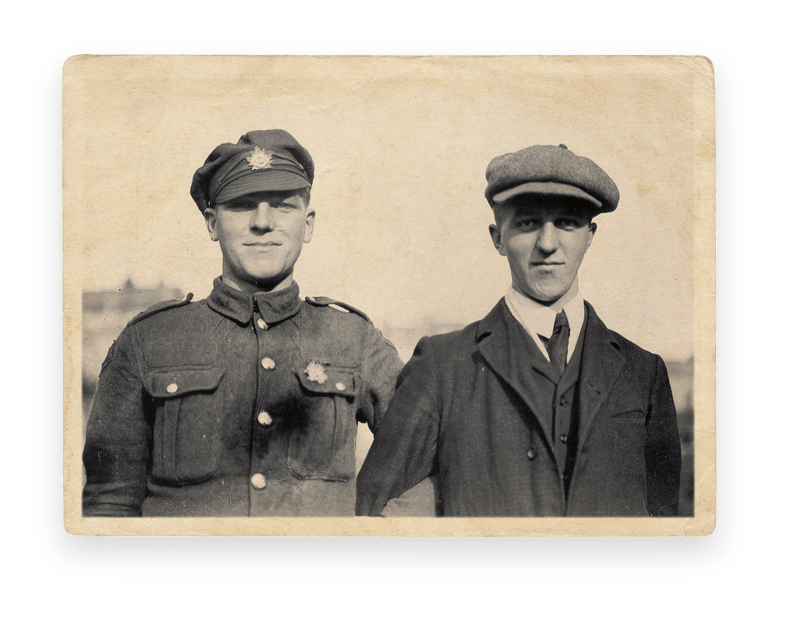
With a pause in the Canadian Corps’ operations, a major liberation celebration was held in Denain on Oct. 27, 1918. Currie attended along with many of the senior staff, but the most glamorous participant was a British staff officer attached to Corps headquarters: the Prince of Wales (later King Edward VIII).
Slight and fair-haired, the 24-year-old prince cut a dashing figure in his military uniform. He was a “remarkably pleasant looking fellow, considering the inspections and liberation festivities he is called upon to be a part of,” wrote Canadian Lieutenant R.J. Holmes.
Thousands of French civilians again lined the streets to cheer the marching Canadian units. Currie and the future king attended a ceremony in Denain’s cathedral, which was described by Major-General David Watson of the 4th Division: “They had many young ladies who were dressed in national costumes and presented all the generals with flowers. The dean of the church made an exceptionally fine address.”
SPOILS OF WAR
General Arthur Currie inspects captured German guns at Amiens during the Hundred Days offensive.
(Chronicle/Alamy/DRFJWP)
As the ceremony ended, with the French honouring Canada’s dead who had fallen during the liberation of the city and the surrounding area, the young prince and Canada’s general left the cathedral to be welcomed by even larger crowds. Throngs of grateful French “were weeping and cheering,” recounted L.F. Pearce of the Canadian Machine Gun Corps.
The French needed no prompting in understanding the importance of the soldiers who had sacrificed all for them to return freedom long lost.
RIGHT
VICTORY MARCH
Prince Edward leads Currie and Canadian Major-General David Watson through the streets of Denain.
(LAC/3522306)
Edward, then Prince of Wales, takes the salute in the liberated town of Denain, France, in October 1918.
(LAC/3522307)
After years of bloodshed and loss, the end seemed to be coming fast. But not fast enough for most Canadians, who wondered why the Germans continued to hold on past all hope of victory.
After the ceremony in Denain, the Canadians waited to see if the British on the right flank, with the 51st Division in the lead, could capture Valenciennes. They faced the strongpoint of Mont Houy—an imposing hill to the south of the city that was an anchor position in the enemy line.
If the British pushed hard, it was hoped, the Germans would fall back from the city. And so the weary 51st Division attacked on Oct. 28 with a weak force of a single battalion. The Highlanders were repulsed with heavy losses.
A German munitions train sits abandoned in Mons, Belgium, in November 1918
(LAC/3397979)
Following three months of fierce battles, Currie’s corps was called on again. The soldiers prepared for a final assault on Nov. 1 in the Canadians’ last set-piece battle of the war. As the guns were dragged into position, many Canadians were buoyed by word that was spreading through the ranks that Turkey—one of Germany’s key allies—had signed an Armistice on Oct. 30.
While Currie understood that his infantry had been pushed hard since Amiens, he also knew his corps had one more battle in it. But the Canadian general was constrained.
The Canadians’ could have steamrolled over the city, shattering it and the German defenders with shellfire, but Currie worried about the French civilians. While most of the original 35,000 inhabitants had fled, some 4,500 remained.
Currie was also anxious for his own cut-up regiments, and he refused to send them into combat without proper artillery support. After pondering the dilemma, he ordered his gunners to focus on dug-in German forces in the fortress of Mont Houy, which would avoid killing civilians.
A scene from a period film depicts German soldiers taking a roadside rest during the retreat to the Hindenburg Line.
(Sueddeutsche Zeitung Photo/Alamy/E003PJ)
“Spare no expense,” Currie told artillery brigade commander Andrew McNaughton. Two hundred and fifty field and siege guns were massed to break the enemy’s prepared defences in a very limited front. In the general’s evocative phrase, he wanted to “pay the price of victory in shells and not in the lives of men.”
The guns were unleashed at 5:15 a.m. on Nov. 1, with the 44th and 47th battalions advancing in the first assault wave up the slope of Mont Houy.
“The smoke, the dust and debris thrown up by the high explosives formed a dense and slowly moving wall behind which the infantry platoon advanced virtually unmolested,” wrote McNaughton. “Enemy soldiers, stupefied and demoralized by the fire that seemed to be hitting them from all sides, surrendered freely.”
The massive bombardment hammering the German defences could be seen for kilometres away, with seven tonnes of explosives dropping per minute on a front of less than 2.5 kilometres.
“Reports [were] that Fritz was not fighting very hard,” wrote one Canadian gunner observing the chilling weight of shellfire. “I don’t blame him, considering the barrage that was let loose on him…. Hun casualties very heavy. Saw more wounded Huns than in any recent shows and reports indicate a great number of dead ones.”
As the Canadian battalions swept forward behind the awe-inspiring bombardment, German defences collapsed over the course of the day. The Canadians drove through Valenciennes.
The German dead lay over the battlefield and buried in dugouts. At least 800 were killed. More than 1,800 prisoners were taken. However, there was also evidence that the frustrated Canadians, who were tired of fighting and had heard many enemy atrocity stories from the newly liberated French, executed German prisoners on the battlefield.
LEFT
French soldiers with a captured German tank in October 1918.
(Legion Magazine Archives)
MEAN STREETS
German soldiers lie dead in the streets of Soissons, France.
(Peter Stone Archive/Alamy/D3T38A)
This was not a new phenomenon, with soldiers of all armies on the Western Front executing prisoners during and after battle, out of fear, confusion or vengeance, but the Canadians were particularly ferocious at Valenciennes.
“We surely got ours back for almost a month of hard chasing and dirty fighting,” wrote Holmes. One Canadian battalion was even apologetic for the number of prisoners taken, writing in its official war diary: “It was impossible to avoid taking so many as they surrendered in batches of from 20 to 50, but some very useful killing was also achieved.”
The Germans were soundly defeated by the Canadians. Enemy soldiers who survived the battle made their way to prisoner-of-war cages.
The Canadians suffered 501 casualties, with 121 killed or missing in action. Some of those slain were men who were new to their units. Combat veterans barely had time to know their names. Others were long-service men who had come through years of combat, teaching new men to survive, leading from the front.
East of Valenciennes, the Canadians moved through a more densely populated countryside. There were thick clusters of villages and towns on the road to Mons, 40 kilometres away. Most of them supported the region’s mining industry that had been incorporated into the German war machine. Conical slag heaps dotted the countryside, and many soot-stained red-brick cottages were scattered about or grouped in small clusters.
Even with the defeat at Valenciennes, the Germans continued to fight aggressively through early November, leaving behind holding forces and rearguard units. Canadian casualties came every day from shelling and firefights.
RIGHT
German prisoners of war face an uncertain future in a French prison camp.
(U.S. National Archives/533461/Wikimedia)
“Credit must be given to the German machine-gunners at this stage in the struggle,” wrote one Canadian. “These men, of whom there were great numbers, were carefully picked and thoroughly trained, and fought their guns with skill and courage until the last minute, often choosing death in preference to surrender. They exacted their toll from the advancing Allied battalions and, more than once, held the attack in check.”
The German artillery turned freely to chemical shells. About a quarter of the shells fired were filled with lethal agents that forced the Canucks to don their small box respirators. This first line of defence against chlorine and phosgene largely protected the wearer—if he got it on his face before inhaling gas—but it exhausted the already tired soldiers, who had grave difficulty marching in respirators, let alone fighting in them. And yet the Canadians still defeated the German sacrificial forces, and set off again to end this bloody war.
Canadian war artist Frederick Varley, a future member of the Group of Seven, painted German prisoners walking a rocky road past dead trees, debris and bodies.
(Frederick Varley/CWM/19710261-0807)
“How wonderful it was to keep rolling on behind the vaunted German war machine,” wrote Company Sergeant Major Percy Kingsley of the 5th Battalion.
But Kingsley also saw how the advance freed civilians who had been trapped behind enemy lines for years. “The spirit of the French population at their liberation made us all realize our efforts of many months were appreciated by the people after their many months of oppression.”
On Nov. 5, the first Canadians advanced into Belgium, even though much of the corps remained in France, continuing to liberate towns and cities, including Vicq, Rombies and Quarouble, and, on Nov. 6, the villages of Marchipont, Baisieux, Crespin and the southern part of Quiévrechain. “The enemy’s resistance was very stubborn,” wrote Currie, although more than 500 prisoners were captured on Nov. 6.
ON THE MEND
Accompanied by a French Sister of Mercy, wounded Canadian soldiers hold a French girl in front of the Hotel Dieu in Valenciennes in November 1918.
(LAC/3395900)
A Canadian patrol makes its way through the streets of the ruined city.
(LAC/3522383)
Fighting in two countries now, the Canadians were greeted by the Belgians who added their choruses and cheers to those of the liberated French.
“A triumphal procession through villages,” wrote gunner Bert Sargent after passing into Belgium on Nov. 8, 1918, “where every house was bedecked with flags and the inhabitants, delirious with joy at their delivery, lined the streets and expressed a welcome born of four long years of tyranny and oppression.”
The Canadian Corps remained in the forefront of First British Army, advancing on a wide front in the drive to Mons. The German forces were broken, but they remained holed up there.
The ancient Belgian city was a key goal. It was known as the place from which the British regular army had retreated in August 1914 in the face of overwhelming German forces. It was a city of symbolic value and the British ordered Currie to capture it. That prize would be the capstone of the Hundred Days for the Canadian Corps, and one final recognizable act of liberation.
Currie’s soldiers at the sharp end were less enthused. They had been pushed hard for too long and had already suffered some 45,000 casualties. Too many chums had been left behind, sent to hospitals with gaping wounds or buried in hastily dug graves. Victory had been won, but at what cost?
This anger was more palpable as the rumours became more virulent that the war was going to end soon.
“One doesn’t feel like taking any risks,” wrote Lieutenant James McRuer on Nov. 7, 1918. Those stories of the Kaiser’s death or the enemy’s imminent surrender, passed from man to man, brought a glimmer of hope, but also fear. No one wanted to be the last man to die in a war that had killed millions.
The Canadian Corps advanced to the outskirts of Mons on Nov. 10, but Currie did not order an all-out assault on the city. He wanted the glory of capturing Mons, but not at the expense of his soldiers’ lives. There were probing patrols but no unnecessary loss of life through an attack.
LEFT
Luxembourgers welcome their liberators after the Armistice.
(U.S. National Archives/530707/Wikimedia)
Canadian troops grab a bite in a trench in France.
(World History Archive/Alamy/EX6NJP)
Outside of Mons, the Royal Canadian Regiment and 42nd Battalion explored avenues into the city, but were met by machine-gun fire. Other Canadian units to the north and south continued to advance, slowly moving beyond the city.
But with Mons in the centre of a large Canadian front, Currie had orders from British First Army to keep pressure on the enemy. With no knowledge of a coming armistice, he ordered another stealthy advance on Mons in the early hours of Nov. 11.
The RCR and the 42nd filtered across bridges and into the city in the darkness. They discovered the Germans had fled, except for a few snipers who had to be cleared out by follow-on platoons and sections that infiltrated the city.
RIGHT
TANK BUSTERS
A German anti-tank rifle crew goes about its work in 1918 France.
(IWM/Q44794/Wikimedia)
Some of the Canadians who walked the silent cobblestone streets ran their bayonets along steel grills outside some buildings and tapped gently on windows. The Belgians of Mons awoke to freedom that had been delivered at the point of a bayonet.
A little after 6 a.m., Currie’s headquarters received a telegram that an armistice would come into effect at 11 a.m.
Telegraphists sent word of the Armistice out to various units and most battalions received the message a little after 9 a.m., usually by runners hand-delivering messages. The Canadians greeted the news with stunned relief, although a few units had already begun their advance for the day. The guns went silent at 11.
Most of the battle-weary soldiers along the front stayed low in their slit trenches after the Armistice, refusing to leave cover and fearful of becoming the victim of some crazed sniper looking to take his last man. But as the silence held and awareness spread, there was a growing sense of quiet relief.
AFTERMATH
Non-commissioned officers of Princess Patricia’s Canadian Light Infantry assemble.
( Album of Nursing Sister Charlotte Isabelle Nixon and 2nd Lieutenant Victor John Nixon/IWM/19780067-004 )
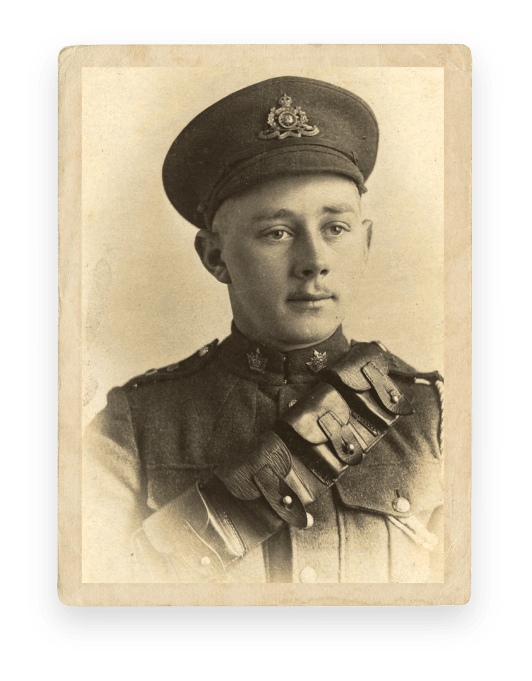
“It was too good to be true,” wrote infantryman Alfred Herbert Andrews. “The boys were almost stunned, not a cheer.”
“Everybody just stood around lookin’ at each other,” recounted Corporal Roy Macfie of the 1st Battalion. “Nobody would believe it.” There was unfettered celebration behind the lines, stretching all the way back to Britain and Canada, but most soldiers at the front took the end of the war with weary disbelief.
Many long-service infantrymen had coped with the mental strain by writing off their lives, having embraced a fatalistic belief that they would get it when a bullet arrived with their name on it. If there was no bullet, they would soldier on until they got it. This was a common, if grim, outlook on the infantry’s chance of survival.
LEFT
Portrait of a young artillery soldier. The liberators (right) march through the streets of Mons, Belgium.
(LAC/3397744; Chronicle/Alamy/MHNYNM)
any of the Canadians who fought through the war, and especially the Hundred Days campaign, framed it as a costly victory.
The survivors were proud of their service, of having done a hard thing together, and in having contributed mightily to the defeat of a skilled enemy. And then there was the sentiment, sometimes in contradiction, sometimes intertwined, that the strain had been terrible and the cost even worse.
A spearhead formation that delivered victory after victory, the Canadian Corps had been pushed hard and suffered heavily in the Hundred Days, with more than 45,000 casualties. It was victory with a heavy price indeed.
The nation and its people should find “inspiration” in the agonizing and costly war effort, especially in the “wonderful idealism of the whole crusade,” wrote poet William Lighthall in December 1918. For Lighthall, and millions of others, “the story is too grand to be forgotten.”
THE COST OF VICTORY
Canadian troops show the wear of a costly and long-awaited victory as they arrive at a dispersal station in Toronto in 1919. Poet William Lighthall (right) urged Canadians to find inspiration in their sacrifices.
(LAC/3642881; Wikimedia)
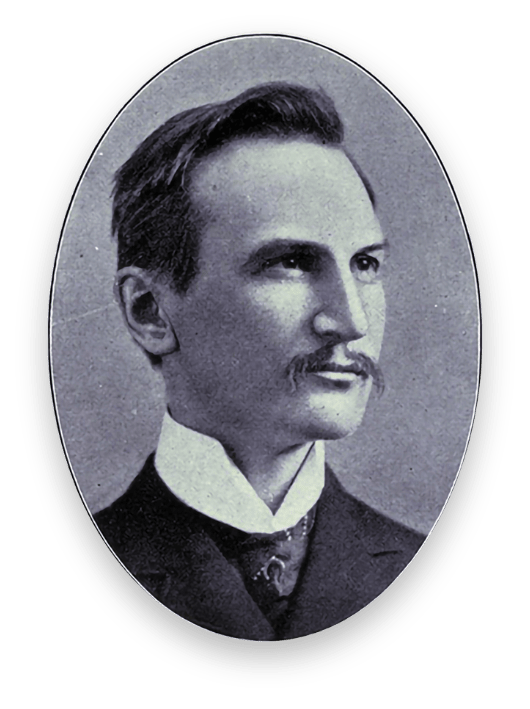
The Great War could never be forgotten. But the meaning of the war has changed over time, evolving with Canadians from generation to generation.
Canadians were haunted by the war, by the terrible losses overseas and the fracturing of the country through the extremity of the war effort. But they were also deeply proud of what the country had done from 1914 to 1918, and how the nation’s service had propelled it forward to emerge as a new nation.
After the Armistice, however, the way forward was not immediately apparent for the victors and vanquished.
“The world has drifted far from its old anchorage,” wrote prime minister Robert Borden, “and no man can, with certainty, prophesy what the outcome will be.”
Canada was unmoored and riven, its people angry and filled with uncertainty. By early 1919, the country was mired in debt, unemployment, labour unrest, fear of the infection of Bolshevism and the shocking pandemic that would take at least 50,000 Canadian lives.
LEFT
ACTS OF REMEMBRANCE
Prime minister Robert Borden (left) launches a 1915 Victory Bond drive in Toronto. Frederick Varley’s oil on canvas (right) is entitled “For What?” In a 1919 letter to his wife Maud, Varley wrote: “I’m mighty thankful I’ve left France—I never want to see it again…. I’m going to paint a picture of it, but heavens, it can’t say a thousandth part of a story. We’d be healthier to forget, and that we never can.”
(William James/City of Toronto Archives/869A/Wikimedia; Frederick Varley/CWM/19710261-0770)
Canadian soldiers returned to a broken, divided and grieving nation. Pensions were paid to the grievously wounded, and land was offered for settlement (although much of it was poor quality). Young men, many aged beyond their years, returned to their communities and wondered what they might do. Jobs were scarce.
Despite the challenges, most “returned men,” as the veterans were often known, settled down. Others went adrift, suffering from physical and mental wounds, and unsure of their future.
There was a “before” and an “after,” and the war years loomed large in survivors’ minds. The sacrifice of Canada’s 66,000 war dead stalked the nation. To mark this gutting wound, individuals, communities, cities, provinces and the national government commemorated the loss.
There was Armistice Day with its two minutes of silence, the poppy adopted from John McCrae’s “In Flanders Fields” and thousands of memorials erected in communities across the country. In Ottawa, the Peace Tower and the National War Memorial were under construction, to be unveiled in 1927 and 1939. Overseas, memorials rose at many battlefields: Ypres, Beaumont-Hamel, Vimy Ridge.
RIGHT
SAME STORY; DIFFERENT TIME
Veterans in Toronto protest the lack of work after the war. Then, as now, veterans struggled with war wounds, both mental and physical, and securing the compensation they’d been promised.
(City of Toronto Archives/903)
The war had changed Canada. The country stood shoulder to shoulder with Britain and other allies, and the effort transformed the populace forever. Vimy Ridge, in particular, took on great importance after the unveiling of the memorial in 1936. The battle and the monument became symbols of Canada’s coming of age.
With the gift of hindsight and study, historians reflected on the war’s importance.
“In 1914,” wrote Donald Creighton, “the nation resembled an overgrown, awkward adolescent who had not quite reached manhood…. It was the war that completed the great transformation and demonstrated its reality for all to see.”
He was echoed by G.W.L. Nicholson, who wrote the official history of the Canadian Expeditionary Force in 1962.
SEMINAL DIVIDE
The introduction of conscription in 1917 exposed and fuelled profound divisions among Canadians, particularly between French and English. civilian clothes and passed as a French civilian.
(CWM)
“As the war progressed, the sense of national unity which permeated the Canadian Corps became stronger and stronger…. The men of the various units from every province in Canada who fought at Vimy Ridge and at Passchendaele and in the battles of the Hundred Days, fought not as Maritimers, or British Columbians, or representatives of Quebec or Ontario or the Prairie Provinces. They fought as Canadians, and those who returned brought back with them a pride of nationhood that they had not known before.”
The war was often viewed differently in Quebec where, despite tens of thousands serving, the idea of conscription was most prominent. But even that divisive theme was linked to evolving societal issues. For instance, in the early 1960s the Quebec separatist movement reframed conscription as a historic symbol of English oppression to use in the contemporary struggle and rewrote the past to better fit the present. Many politicians and intellectuals in Quebec chose to highlight conscription—the forced service of thousands—instead of the many French Canadians who served willingly and bravely in uniform.
RIGHT
POINT OF PRIDE
Accompanied by President Albert François Lebrun of France, King Edward VIII unveils the Canadian National Vimy Memorial on July 26, 1936. Thousands made the transatlantic pilgrimage to see the memorial to 11,285 Canadian soldiers who died in France and had no known grave.
(Smith Archive/Alamy/2BW3P7C)
Many English Canadians turned to Vimy as a powerful symbol. “It was the birth of a nation,” said prime minister Lester B. Pearson, a Great War veteran, in 1967 on the 50th anniversary of the Battle of Vimy Ridge.
“It is appropriate that as we celebrate the centennial anniversary of the creation of our country,” he said, “we should recognize the one event which above all others made it a nation, half a century later.”
Amid sometimes heated debates about the war’s meaning, which were shaded by contemporary commentators or politicians, the idea of liberation was pushed aside. It was neither linked to the concept of the sacred fallen, nor the question of nationhood emerging as symbolized by Vimy, nor the war’s darker legacy in Quebec (and among some persecuted groups, such as the 6,000 interned Ukrainians). These three dominant strands of memory were entangled and entwined, taking on contested meanings among different groups of Canadians, but they left little place for the concept of liberation.
C’EST FINI
Led by relieved and excited children (left and right), members of the 42nd Battalion (Royal Highlanders of Canada) march through the streets of Mons, Belgium, on the morning of Nov. 11, 1918.
(Legion Magazine Archives; LAC/3522364)
The history of a non-event is not easy to untangle. But the liberation idea was not marked with memorials; it was not an idea that led to intense debate about the nation-building or rending effects of the war, and it became even more foreign from the 1960s on, when there was a new generation of writers, historians and filmmakers who condemned the war and the “butchers and bunglers” who oversaw it.
Perhaps most important, the idea of a war fought for freedom and liberation was much more prominent in 1945. If the Great War led to Canada’s coming of age, the Second World War was the Necessary War against Hitler and the fascists. Few at the time, or since, have questioned the utter need to defeat the fascists with their mad dreams of conquest and genocide.
Canadians engaged in the crucial work of saving the Dutch from mass starvation was a more powerful symbol of liberation than that which drove Canadians during the Great War, especially in the liberation phase of late 1918.
As Canadian veterans lost their war against age, to join thousands of comrades who lay buried under Commonwealth War Graves Commission headstones overseas, the idea of a just and necessary war to liberate the French and Belgians faded from memory. The great passing of this generation occurred in the 1960s, leaving fewer and fewer Great War veterans.
The liberation idea was buried with them.
RIGHT
HOME AGAIN
Canadian troops wait patiently, or not, to disembark after their hospital ship arrives in Halifax at war’s end. Their role as liberators in France and Belgium would fade from memory back home after their successors in Europe liberated the Netherlands following five years of Nazi occupation.
(LAC/3198701)
he actions of Canadians during the Great War were not driven solely by the idea of liberating Western Europe. More important was to stand by Britain or to serve Canada’s emerging national interests, although there was never simply one motivating factor.
And yet the liberation idea mattered. The Canadians who left behind their loved ones and fought overseas often spoke of the notion of freeing the Belgians and French in their contemporary diaries and letters—or later, in written memoirs and interviews. As one Canadian medical officer wrote of the final month of the war, “one and all were looked upon as heroes and deliverers from oppression.”
What does it mean to return a people their freedom? The Kaiser’s soldiers were not like the genocidal Nazis of the Second World War, but they were still cruel overlords. The Canadians delivered the brutalized French and Belgians from the fear of soldiers who could take anything and do almost anything, snatching dignity, beating down one’s will to live, physically and mentally abusing, and sometimes murdering with little fear of punishment.
GESTURE OF THANKS
A citizen rushes to give a triumphant Canadian soldier a rose during a May 1919 “peace parade” of dominion forces along Victoria Street in London, the first of two celebratory spectacles in the city that year. The Canadians were in the procession of dominion formations comprising tens of thousands of soldiers, sailors, airmen and nurses, along with tanks, guns and German war prizes.
(Trinity Mirror/Mirrorpix/Alamy/B4NDH9)
With bayonets and shells, the Canadian shock troops restored dignity, pride and liberty. They did not do it alone, but they punched far above their weight in the war’s many campaigns, and especially during the Hundred Days.
“We Canucks have never forgotten those French and Belgian people who anointed us with the oil of kindness,” wrote Victor Wheeler, who fought through the war and was part of the final liberation.
Unfortunately, Canadians did forget. Why we continue to mark and remember the 1945 liberation but not the 1918 liberation tells us something of the difference in the constructed memory of the two world wars, as well as something about exploring the complexity of social memory and public commemoration.
We need not call the Great War a Necessary War, as the fight against Hitler and the other fascists surely was, but 100 years later, we might restore the idea of liberation to the memory of Canada’s Great War. And we might remember that Canadians fought for many reasons, not the least because they understood that this was a war that had to be won against a grim and resolute enemy who acted as aggressor and occupier.
FULL STOP
Members of the 42nd Battalion (Royal Highlanders of Canada) rest in place at the Grand-Place in Mons, Belgium, on the morning of Nov. 11, 1918. The war had been over for less than an hour.
(CWM/19930065-429)
Canadian Major-General Edward Morrison and other officers talk with liberated Belgians near Mons, including a women wearing a Canadian badge.
(LAC/3397235)
It is worth returning to the last major liberation of the war for the Canadians, the capture of Mons and a ceremony held there on Nov. 13, 1918.
Two days after the Armistice, the Canadians conducted a funeral service for those killed in the days leading up to the end of the war. Major G.D. Kilpatrick of the 42nd Battalion spoke at the event in the presence of a huge crowd of Belgians who came to pay their respects to their fallen liberators. The Canadians were buried in an old cemetery at Mons, with pipers playing and buglers sending out the call of “The Last Post.”
“So we left them, our honoured dead, not on alien soil but in that corner of a foreign field which is forever Canada,” said Kilpatrick.
RIGHT
THE LIVING AND THE DEAD
Dead and living march side-by-side through a shattered, deeply symbolic landscape on the Western Front in this Eric Kennington painting, “The Conquerors.”
(Eric H. Kennington/CWM/19710261-0812)
The cemetery in Mons and many others beyond Canadian soil remain powerful sites of reflection, memory and sorrow that mark the 66,000 Canadians who were killed in the war. They are also stark reminders of the struggle for liberal ideals that carried countless Canadians into the war.
Those silent cities that are forever a part of Canada are a reminder of how the impulse to save an oppressed people drove many Canadians to enlist, to leave behind their families, to go forward in the name of liberating the people of occupied France and Belgium, and to be willing to make the sacrifices required of victory.
To be sure, the Canadians went as warriors—they were no peacekeeping force—and to be sure, they paid a terrible price. But in the end, they brought liberation through toil and blood, relentless battles and fierce combat.
RIGHT
Private George Price (right) of Falmouth, N.S., is believed to be the last Canadian killed in the First World War. Aged 25, he died at Mons about two minutes before the Armistice took effect. He’s buried at St. Symphorien Military Cemetery just east of the liberated city. A poppy blooms at Tyne Cot Cemetery near Ypres, Belgium, resting place for 11,961 Commonwealth soldiers.
(Wikimedia; The Tourist/Alamy/DPWABG)
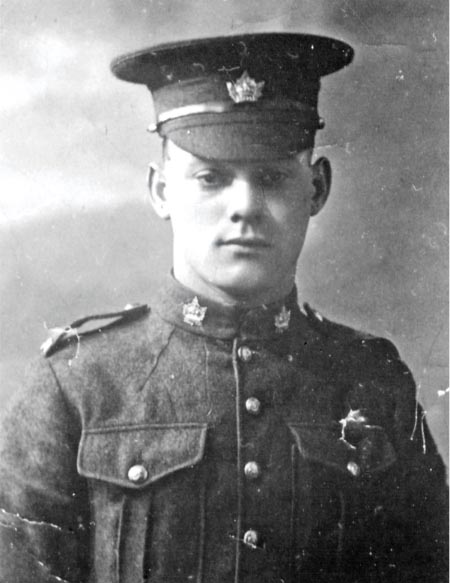
During the final liberation phase, journalist J.F.B. Livesay wrote of seeing a Canadian infantryman taking delight in sharing his rations with impoverished French children who had suffered severely almost all their lives under the German occupation. The war was imprinted on their tiny bodies, through malnourishment and unimaginable psychological trauma.
And yet these children cheered and laughed with the Canadian soldier who was far, far from his family. In that moment, the soldier, with tears in his eyes, turned and said, “For all we have gone through, our dead have not died in vain.”
LEFT
ALLONS ENFANT DE LA PATRIE
Crowds parade through the streets singing “La Marseillaise” on Armistice Day in Paris.
(American National Red Cross/U.S. Library of Congress/2017666573)
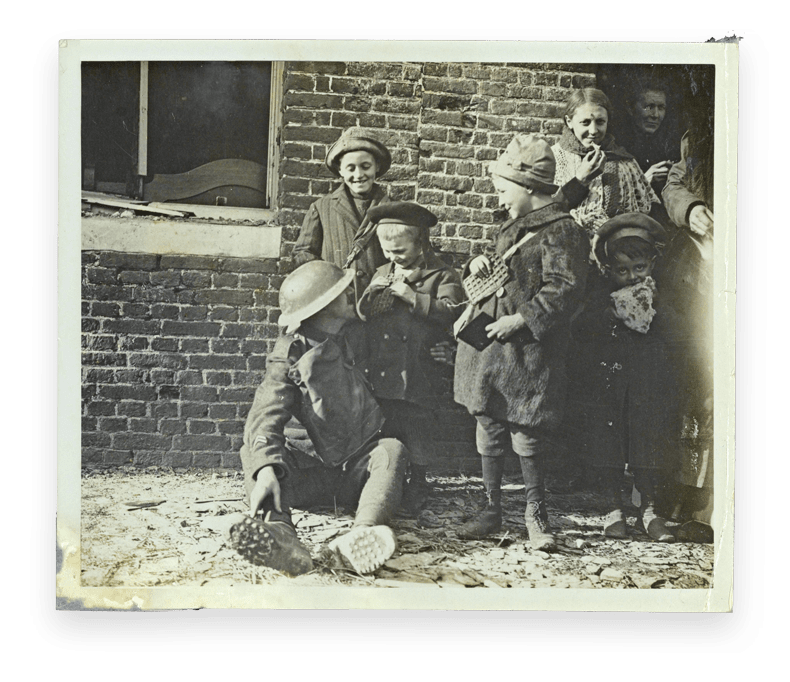
Major A.G. Routier of the 22nd Battalion (French Canadian) stands among admirers. Grateful French children (left) greet a Tommy in the liberated village of Brancourt on Nov. 17, 1918.
(LAC/3220658; Dutch National Archives/Wikimedia)
RETURN TO MONS
Grateful citizens of Mons, Belgium, welcome their Canadian liberators on Nov. 11, 1918, depicted in Inglis Sheldon-Williams’ 1920 oil-on-canvas.
(Inglis Sheldon-Williams/CWM/19710261-0813)